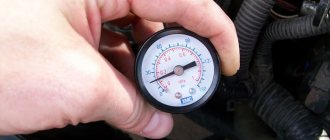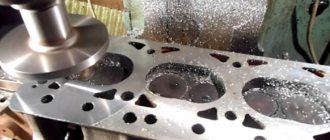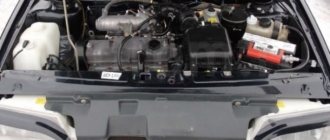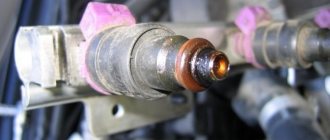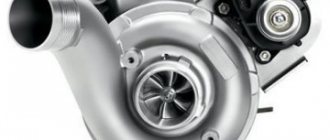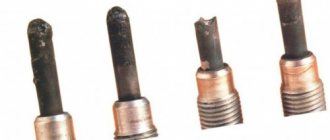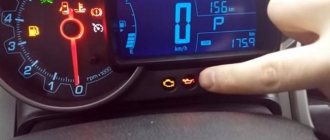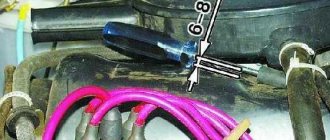The main reasons for the appearance of blue smoke from a car muffler
An owner who knows the slightest bit about how a car works knows that oil can get into the combustion chamber only in two ways:
- through piston rings;
- through the gap between the guide bushings and the valve stems.
From here we can already identify several groups of reasons why bluish smoke appears from the exhaust pipe and oil consumption increases:
- change in cylinder geometry;
- piston ring defects;
- scoring on the cylinder surface;
- wear of the oil seal;
- valve leakage.
Let's take a closer look at some of the reasons from the list above.
Piston ring defects
One of the most common reasons leading to excessive consumption of lubricant. Compression rings wear out not only on the outer planes, but also on the end planes due to the high gas pressure in the cylinder. Moreover, worn grooves of the structure can create a “pump” effect, i.e. pump oil directly into the cylinder, even if the oil scraper rings are fully functional.
Violation of cylinder dimensions
Cylinders often wear out where the top ring stops when the piston reaches TDC. Also in the middle region of the cylinder, changes in its geometry towards an ellipse are observed. When carrying out diagnostics, it is important to accurately determine all deviations of the cylinder from the circle; this is the only way to get rid of the fact that blue smoke is coming from the muffler and excessive oil consumption is noticed. To do this, a series of independent measurements are made:
- in two vertical planes of the cylinder;
- in four levels horizontally of the node.
Cylinder defects
Unpleasant things like scuffs and scratches on the cylinder bore also allow oil to penetrate. The causes of such defects may be:
- abrasive particles due to unsatisfactory filtration of the lubricant;
- long-term parking of the car, as a result of which corrosion may occur on the rings and cylinders;
- non-compliance with power plant repair technology and the use of low-quality parts.
This is interesting: How to check the mass on a car
White smoke in car exhaust
The white color of the smoke indicates that there is some kind of liquid in the exhaust tract. Water can most often enter the system in the form of condensation, which forms during sudden temperature changes. Less commonly, this occurs due to leakage through the end of the exhaust pipe if it is bent upward.
Therefore, if white smoke comes out of the exhaust pipe in sunny weather, you need to look for the cause of this in the power unit. Liquid can get into it in two ways: low-quality fuel or a leak in the cooling system.
In the first case, the problem can be resolved very simply by replacing it with a high-quality analogue. But with the cooling system things are much worse. The most likely cause of antifreeze getting into the exhaust could be a burnt-out engine gasket. Indirect signs of this may be a sweetish smell from the exhaust pipe and clean candles. In any case, when white smoke appears in the exhaust, first of all it is necessary to check the presence of liquid in the expansion tank of the cooling system; there should be more of it than the minimum mark indicates. If the reservoir is empty, then most likely you will have to replace the gasket.
Blue smoke from the exhaust pipe may appear immediately after starting the engine, usually due to small amounts of engine oil entering the cylinders. After a few seconds, the oil burns out and the color of the exhaust is restored. If in this case there is no increased oil consumption and wear of the working rings, then this is not a serious problem.
The presence of a thick white cloud, when there is a lot of smoke from the exhaust pipe, most often indicates that a large amount of coolant has entered the power unit. This can happen when the oil seals (gaskets) are severely worn or when cracks form in the cylinder heads.
In the first case, it is enough to replace the gaskets. The second problem is more serious and cannot be avoided without contacting a car service.
Constant white smoke in the exhaust on cars equipped with vacuum valves with a hose for the power unit appears as a result of insufficient valve tightness. In this case, there is no great risk of serious problems, except that the spark plugs are constantly becoming dirty.
Why is there blue smoke coming out of the exhaust pipe?
Before diagnosing a breakdown, you must remember that the amount and color of smoke and steam from the exhaust pipe depends on the following factors:
- engine heating level;
- quality of motor oil;
- number of engine revolutions;
- air temperature and humidity.
Usually the amount of smoke is greater in wet weather, so deviations in its color and impurities are easier to notice then.
The color of the “blue” smoke itself may vary. Starting with blue and ending with a thick, rich blue. However, in any case, its characteristic feature is its oiliness. It is this that allows us to establish the cause of its appearance. Such smoke does not disperse well into the air, and it contains greasy droplets that literally fly out of the chimney along with the gases. Unlike white smoke, which is caused by the appearance of coolant in the cylinders, blue smoke tells the car owner that oil is entering the combustion chamber.
At the slightest suspicion of blue smoke emerging from the exhaust pipe, it is necessary to measure the oil level in the engine.
In addition to the direct appearance of blue smoke from the exhaust system, there are a number of indirect signs indicating that oil is getting inside the cylinder:
- the engine “troits” (operates unstably);
- the level of engine oil consumption increases significantly (can reach 1 liter per 100 km);
- rapid failure of spark plugs;
- decrease in compression value in one or more cylinders;
- there may be problems starting the car in cold weather;
- presence of a burning smell in the cabin or around the car.
How does oil get into the cylinders?
Most often (but not always) oil enters the combustion chamber in one of two ways, in particular through:
- piston rings;
- clearance between valve stems and guide bushings;
- problems with the turbine (on turbocharged engines).
Why does oil get into the cylinders?
Based on the information above, you can easily identify those parts whose malfunctions led to the appearance of blue smoke from the exhaust pipe. In particular, these reasons include:
- complete or partial depressurization of the valve;
- significant wear or failure of the valve stem seal;
- the appearance of scratches on the surface of the cylinder;
- defects in the operation of piston rings;
- changing the geometric dimensions of one or more cylinders.
Valve stem seals
When the valves burn out or leak, the smoke turns white-blue. It is not difficult to determine the malfunction. To do this you need to measure the compression. It will be insignificant or absent altogether. Now let's look at some of the situations described.
Wear of valve stem seals
When they tan or crack, the amount of oil entering the cylinders increases at idle and during engine braking. At this time, a large vacuum occurs in the intake manifold. As a result, a large pressure difference occurs and oil seeps into the cylinders and accumulates on the walls in the exhaust system. The moment the throttle valve opens, the density of blue smoke with oil increases.
Defects in the condition of the cylinders
Surface of a worn cylinder
Most often this is the appearance of scoring or various defects on the surface of the cylinder. Because of them, depressurization occurs and oil enters the combustion chamber. The reasons for the appearance of these defects may be:
- Presence of abrasive particles in the oil. This may be due to poor oil quality, a clogged filter, or significant mileage of the car without changing the engine oil.
- Corrosion on rings or cylinders. It can occur due to various reasons. One of the most common is parking a car outdoors for a long time without starting the engine.
- Defects during engine repairs or the use of defective parts (in particular pistons and piston rings).
Changing the cylinder geometry
By and large, this is a natural process that occurs gradually as the engine operates. Diagnostics must be carried out at a service station, since special equipment is used for this. Measurements are carried out according to:
- along two vertical planes;
- three to four levels horizontally.
Occurrence of rings
Coked piston
They are also a common cause of blue smoke coming from the tailpipe. The fact is that there are holes on the piston that are gradually clogged with burnt oil. At the same time, the valves and cylinders are in good condition, and only the rings are coked. The reason for this may be the use of low-quality fuel and/or oil. Because of this, the rings do not remove heat from the cylinder walls well. In this case, blue smoke appears when the car accelerates. At the same time, compression decreases.
The operation of the crankcase ventilation system is also disrupted. It is designed to separate oil and regulate the flow rate. Accordingly, when a malfunction occurs in its operation, the pressure of the crankcase gases increases.
In the event of a malfunction of the engine cylinder-piston group, the compression should be measured. However, if the resulting gaps are small, then there is a possibility that the compression value will be high, since the incoming oil will gradually seal them.
Causes of blue smoke
Possible Causes of Blue Smoke
WHAT DOES BLUE SMOKE FROM THE SILENCER SAY? FEATURES AND REASONS FOR APPEARANCE
Good afternoon, in today’s article we will tell you about blue smoke from a car’s exhaust pipe and what vehicle problems it indicates.
In this article we will talk about the main reasons for the appearance of blue exhaust gases from the muffler and which part of the car urgently needs repair or replacement. In addition, we will analyze in detail such basic vehicle defects as severe wear of piston parts, malfunction or natural wear of valve stem seals and wear of valves, which can create a blue tint to the exhaust gases. In any car, over time, failures and malfunctions of certain devices, as well as parts that can disrupt the stable operation of the car engine, may occur. Such failures or breakdowns are usually reflected in the color of the vehicle's exhaust gases. Few car owners pay attention to the smoke from the exhaust pipe, and especially its color. However, it is the color of the exhaust gases that may indicate a specific problem with a particular element of the internal combustion engine (ICE). The colors of exhaust gases are: black, white (gray blue) and blue, each of which determines a particular problem in a car engine or another important system.
So, let's begin to consider the pressing question of why blue smoke appears from the exhaust pipe of a car.
1
.
Blue tint of vehicle exhaust gases
One of the main reasons for the blue tint of exhaust gases from the exhaust pipe is the penetration of engine oil into the working area of the car engine cylinders. Motorists call blue exhaust gases “oil” and they can be blue, light blue or hazy, white-blue. Each shade may indicate a specific problem in a particular engine system.
Smoke from an “oil” type exhaust pipe is usually accompanied by increased consumption of motor oil by the car’s engine. For example, if the consumption of motor oil is half a liter per hundred kilometers, then blue smoke may be visible when the vehicle accelerates, and if the consumption of motor oil reaches a liter per hundred kilometers, then this phenomenon occurs even when the car is idling. When engine oil consumption reaches 1.5 liters or more per 100 kilometers, this indicates complete wear and tear of some internal combustion engine systems; by the way, the shade of the exhaust gases in this case becomes bright blue, with clear contours.
We also note that “oil” type exhaust smoke, in comparison with ordinary steam, is not able to dissipate in the atmosphere, because it contains a large amount of fatty components of motor oil, which exit the exhaust pipe along with the exhaust gases of the vehicle. Oily components in exhaust gases sometimes make up up to 45-50 percent of the total composition of exhaust gases, so they are physically unable to dissipate in the atmosphere.
2
.
Reasons for the appearance of blue smoke from the exhaust pipe of a car
A fairly common reason for the appearance of blue smoke from the exhaust pipe of a car is severe wear of the cylinder-piston group of vehicle parts. As a rule, in this case, wear occurs on the upper type compression rings in the outer and inner surfaces, which are in direct contact with the working area of the engine cylinder. In addition, the cause may be increased wear and the formation of grooves in the rings of the piston itself. At the same time, parts such as valve stem seals
may be fine, but engine oil will penetrate into the working area of the cylinders, since the upper type rings constantly pump oil from the lower level to the upper one.
the compression level usually decreases
and an increase in crankcase gas pressure with increased wear of the cylinder-piston group of car engine parts. It is necessary to take into account the fact that the increased volume of engine oil, which penetrates into the working area of the cylinders, perfectly closes the holes in the parts. If the holes are sufficiently large in size, then, as a rule, engine compression indicators are at the optimal level. The above circumstance very often makes it difficult to find the main reason for the appearance of blue exhaust smoke from the exhaust pipe.
It's all about oil
With this diagnosis, the “cloud” from the exhaust pipe will smoke from light to dark shades. It will depend on the concentration of oil that flows into the combustion chambers, engine operating conditions and warm-up temperature. At the same time, you will feel the burnt smell characteristic of the oil.
The appearance of such gas will be indicated by increased oil consumption. To solve this problem, you need to decide on suppliers of “unnecessary” fluid.
Wear of the cylinder-piston group
Very often, a diesel engine produces bluish smoke due to wear of the cylinder-piston group and timing components (gas distribution mechanism). Oil can get into the cylinder for several reasons.
- The piston ring clearances have been increased.
- The gaps between the valve stems and guide bushings have been increased.
- There is damage on the cylinder liner.
- The rings are destroyed.
- There are violations of the piston grooves and many other reasons.
For example, severe gap defects in the area of the piston grooves allow the combustion chamber to “suck” oil. This is possible even if the oil scraper rings are in good condition. With a long period of operation, the cylinders can change their shape, for example, become elliptical. Due to changes in shape, compaction deteriorates.
Wear of this group of parts also causes a decrease in compression. When measuring compression, it is worth taking into account the ability of the oil to seal gaps. It turns out that if the cylinder is faulty, then the compression should be too high. To carry out diagnostics of the CPG (cylinder-piston group), take measurements and obtain an accurate assessment, certain requirements must be met.
If the mechanisms do not have a very large deterioration in quality, then the notorious smoke can be seen when the engine warms up. After warming up, the level of the symptom decreases or disappears completely. This is explained by the fact that at high temperatures the parts expand and the gaps become sealed.
An increase in oil consumption occurs when the bridges between the piston grooves break down. Also, high oil consumption is caused by broken rings as a result of wear or overheating of the engine. If you use low quality oil and do not change it on time, the piston rings seem to “stick” and lose their mobility.
Deterioration of the piston rings and cylinder seals will cause increased fuel consumption.
The fact of oil ingress can be detected by the characteristic noise in engine operation and knocking, accompanied by changes in speed and load on the engine.
Timing belt faulty and other reasons
Oil smoke can be caused by the following:
- Burnt or damaged valves.
- Worn valve stems and guides.
- Malfunctions in valve stem seals.
Why blue smoke is emitted on a warm engine can be explained by relying on the fact that the oil dilutes with increasing temperature of the internal combustion engine. The following example can be given. This can always be observed when tractors are operating.
It often happens that when the engine is idling, oil accumulates on parts, forming films, thereby accumulating in the exhaust system. Then when the tractor driver presses the gas pedal, the exhaust pipe splashes out thick blue smoke.
The fuel supply system may be faulty or the valves may not be tight. All this can cause a diesel unit to smoke blue. A burnt-out valve gives the exhaust gases a white-bluish tint. This valve defect can be traced to the low compression of the faulty cylinder. Plugs are also susceptible to carbon deposits and deposits, which will indicate this deficiency.
Turbine malfunctions are possible. They may resemble the symptoms of unhealthy valve stem seals. To make sure of this, you can probe the turbocharger pipes for the presence of oils. Turbocharger seal problems are more difficult to identify because the oil that enters the exhaust system burns completely.
Also, the causes of blue smoke may be malfunctions of the crankcase ventilation or problems with ignition in the cylinder. Very often, blue smoke is accompanied by a decrease in thrust, and atmospheric and turbo diesel engines may have seal leaks, etc.
It is worth noting that the reasons for this behavior of the car may be poor fuel quality. Therefore, you should only refuel from those companies that provide good quality fluids. Beware of gas stations that offer diesel fuel at a low price.
Black smoke from the exhaust system
Detecting black smoke from the exhaust pipe is quite easy in any weather. Most often, this situation is the result of incompletely burned fuel entering the exhaust tract. In this case, black carbon deposits also appear on the exhaust pipe. The reasons for this can be a variety of problems, ranging from low-quality fuel, failure of spark plugs, and ending with incorrect operation of the carburetor or compression problems. In this case, as a rule, a persistent pungent odor appears from the exhaust pipe.
First of all, it is recommended to check the condition of the spark plugs. If some spark plugs are covered with a matte black soot, then most likely the problem is in them or in the wires that are connected to them, or in the ignition coil.
On carburetor-type power units, the appearance of black smoke in the exhaust is quite often a consequence of improper adjustment of the carburetor, including the float chamber needle.
For injection-type power plants, first of all, the cause of the appearance of black smoke must be sought in sensors, injectors or control unit settings. As a rule, this can be found out during computer diagnostics. In any case, the easiest way is to find the cause and fix the problem at a service center.
How to understand the reason
Devices with a carburetor injection system generate black smoke as a result of fuel overflowing into the float chamber. You will have to diagnose the condition of the air supply jets and needle valve and, if necessary, replace them.
Injection systems suffer from over-enrichment of the mixture due to incorrect operation of the sensors. The injectors themselves tend to lose their tightness. As a result of overflow, the combustion chamber is oversaturated with fuel, which causes the cylinder walls to become dry - the lubricant burns out.
To initially determine the cause, you do not need to go to the market for special equipment. All you need is a compression gauge. The sequence of actions is as follows.
- Unscrewing the spark plugs from the cylinder head.
- Engaging the handbrake.
- Transferring the box to neutral mode.
- Install the compression gauge head with a certain force so that it fits into the hole where the spark plug is screwed.
- Crank the crankshaft with the starter for two to three seconds.
- If the value is small, re-check with preliminary addition of 25 grams of oil.
By the increase in compression after adding oil, you can understand that the piston rings need to be replaced, as they are badly worn.
Oil from the air
During the intake stroke, the air (or the fuel-air mixture in carburetor engines) first passes through the air filter. Often the driver does not pay attention to the condition of the crankcase ventilation system, which is why the channels become clogged with oily deposits, and the increased pressure of crankcase gases pushes engine oil into the air filter housing.
For a careless driver, the filter element is often unable to retain liquid lubricant, and it enters the cylinders with air.
For turbocharged engines, the rotor is lubricated with liquid oil using a special oil pump. Due to wear, the gaps in the bearings increase, through which oil begins to flow into the cold (air) cavity of the turbine. Here it is sprayed by the impeller and mixed with the forced air, after which it enters the combustion chamber.
Another rare case, occurring only on cars with an automatic transmission equipped with a vacuum load sensor. The latter is connected to the intake manifold using a hose. Sometimes it happens that the sensor diaphragm breaks, and the vacuum in the manifold sucks oil from the box. Not only does the box lose one of the control systems and lose oil, but it is also the culprit of engine smoke.
This is interesting: At what mileage should I change the timing belt on a Nissan Qashqai?
Black smoke
Black smoke from the exhaust pipe indicates an over-enrichment of the fuel-air mixture, and, consequently, a malfunction of the fuel supply system. Such smoke is usually clearly visible against a light background behind the car and represents soot particles - products of incomplete combustion of fuel.
Black smoke is often accompanied by high fuel consumption, poor starting, unstable engine operation, high toxicity of exhaust gases, and often loss of power due to a non-optimal air-fuel mixture. In carburetor engines, black smoke usually occurs due to overflow in the float chamber due to a defective needle valve or due to coking of the air jets.
In gasoline engines with electronic fuel injection, over-enrichment of the mixture usually occurs due to malfunctions and failures of various sensors (oxygen, air flow, etc.), as well as leaking injectors. The latter case is dangerous due to water hammer in the cylinder during startup with all the consequences mentioned above. The bottom line is that a lot of fuel can leak into the cylinder through a faulty injector when the engine is not running, and it will not allow the piston to approach top dead center. In diesel engines, black smoke sometimes appears not only when the high-pressure pump malfunctions, but also when the injection advance angle is large. Common to operating modes of gasoline engines with an over-enriched mixture is increased wear and even scuffing of parts of the cylinder-piston group, since excess fuel washes away oil from the cylinder walls and impairs lubrication. In addition, fuel enters the oil and dilutes it, worsening lubrication conditions in other related engine parts. In some cases, this dilution is so great that the level of oil in the crankcase (more precisely, the mixture of oil and fuel) increases significantly. Diluted oil takes on a distinct gasoline smell. It is obvious that operating an engine with such malfunctions is not only difficult, but also extremely undesirable, since it quickly leads to new, much more serious troubles.
So, black smoke tells us about a rich fuel mixture. In turn, this leads to malfunctions in the power supply system or ignition, or a malfunction in the fuel injection control. The black smoke from their exhaust pipe is a consequence of improper combustion of the combustible mixture. It can be clearly seen in daylight, small particles of soot will be visible.
By the way, black smoke from the exhaust pipe is often accompanied by increased gasoline consumption, and the concentration and toxicity of exhaust gases also increases, the engine does not work correctly - it is unstable, it is difficult to start, and also often leads to a deterioration in the dynamic qualities of the car. In carburetor engines, as already mentioned above, you can find out the problem from this article - a rich fuel mixture.
Black smoke from the exhaust pipe of injection engines often appears due to a malfunction of the oxygen sensor, air flow sensor, etc. Another common malfunction with a rich mixture is leaking injectors. By the way, if the injectors are not sealed, water hammer is possible. A leaky injector is too dangerous. Because even when the engine is not running, a large amount of fuel can leak into the cylinder, and the piston will not be able to rise to the dead center.
Now let's talk about black smoke from the exhaust of diesel engines. The cause of black smoke may be a malfunction of the high-pressure pump or an incorrect injection timing. All engines with a rich mixture are characterized by increased wear of the cylinder-piston group. This occurs due to poor lubrication of the cylinder-piston group, because excess fuel washes off the oil from the cylinder walls. Also, oil, when mixed with gasoline, impairs the lubrication of all other engine parts. Do not delay repairs if you notice black smoke coming from your car's exhaust pipe.
You can select the engine for your car on our website
Blue smoke
If oil gets into the cylinder cavity, blue smoke may appear from the exhaust pipe. The reasons for this may be:
- significant wear or sticking of the piston rings;
- violation of the tightness and elasticity of the valve stem seals;
- turbine malfunction, if provided for by the design.
After prolonged use or as a result of regular overheating, the elasticity of the oil seals installed on the valves deteriorates. As a result, some of the oil flows down the valve surface and enters the cylinder.
If blue smoke is detected in the exhaust, when there is no increased oil consumption, experts recommend starting to diagnose the problem by measuring compression. If the results are quite acceptable, then the cause of the problem is in the valve stem seals.
Fellowship of the Rings
Now let's talk about how oil gets from the crankcase directly into the working chamber. Pistons of internal combustion engines (ICEs) operate under conditions of high temperatures and significant friction forces. Oil poured into the engine crankcase is used to lubricate and cool the rubbing surfaces. It is supplied to the cylinder walls by spraying or under pressure using special piston nozzles.
During the upward stroke of the piston, an oil film is applied to the surface of the liner; during the downward stroke, the oil scraper ring removes the heated lubricant, taking heat from the cylinder walls. Compression rings are used to isolate the combustion chamber from engine oil, as well as to create a certain pressure (compression) in it.
Typically, the pistons of a gasoline engine have 3 rings (like the elf tribe): one lower - oil scraper and two upper - compression.
As a result of wear of the compression rings, hot working gases begin to break into the crankcase space, which leads to an increase in the medium pressure in it. And due to the vacuum formed above the piston head, oil from the crankcase is sucked into the cylinder cavity. Thus, oil enters the cylinders due to wear of parts of the cylinder-piston group (CPG). What can contribute to the development of this process:
- Wear of oil scraper and compression rings. Leads to an increase in gaps, as a result of which the barrier between the gas and oil environments disappears.
- Development of piston grooves. As their width increases, the performance of the labyrinth seal deteriorates, and a suction effect also occurs, due to which the oil is pumped from the crankcase into the cylinder, as if by a pump.
- Destruction of intergroove bridges. This defect is often observed on pistons due to a phenomenon called thermal fatigue of the material.
- Coking of rings. When oil burns, carbon deposits form, which deprives the rings of mobility, and they lose the ability to elastically press against the cylinder walls.
- Changing the shape of the cylinder walls and piston geometry.
- Seizures that form on the cylinder walls due to improper operation of the lubrication system (oil starvation).
- Poor quality lubricants or the use of oil with inappropriate performance characteristics, for example, the wrong viscosity.
- Installation of rings without using a special puller. In this case, the part is deformed, which leads to accelerated wear of the cylinder mirror.
Blue smoke when starting cold!
All engines, regardless of the conditions in which they are used and what fuel they operate on, have a certain service life. Some engines have more, and some have less. One of the main breakdowns that entails a major overhaul is wear in the cylinders, wear of the compression and oil rings on the pistons, wear of the valve liners and wear of the oil seals, which are located directly on the valves. All this can be diagnosed independently. You just need to pay attention to the following signs:
1.
When the engine starts, blue smoke comes out of the exhaust pipe;
2.
The presence of oil on the threads of the spark plugs (this symptom applies only to gasoline engines and indicates wear of the oil seals on the valve stems).
If blue smoke appears when starting the engine, but then it disappears, this indicates that it will not disappear soon, and the longer the owner reschedules a visit to a service station, the more expensive it will cost him. "capital".
It is not uncommon for an engine to smoke blue smoke “when cold.” The reason for this may be that after a long trip, when the oil in the internal combustion engine is quite hot and has a more liquid form, it flows through worn piston rings and valve stem seals. Thus, the oil enters directly into the combustion chamber even when the engine is turned off. Because of this, during the first start-up, when the combustible mixture ignites, the oil that was in the combustion chamber burns out simultaneously with the fuel. Blue smoke when starting the engine may appear because an oil film always forms on the cylinder walls, which helps the pistons slide. This oil also burns out, only in this case there is much less smoke, and it can be noticed by a person whose eyes are “trained”, in other words, someone who has extensive experience in operating vehicles.
Blue smoke in diesel cars, diagnostics, causes
Why does a diesel engine produce blue smoke? Diesel engines, as already mentioned, are also subject to gradual wear. Overheating can speed up the wear process. In order to avoid it, it is necessary to control:
1.
The amount of antifreeze/antifreeze in the expansion tank;
2.
Functionality of the cooling fan switch sensor;
3.
Serviceability of the coolant temperature sensor;
4.
Integrity of pipes and radiators of the cooling system and stove;
5.
Presence of oil leaks between the cylinder block and the valve head;
6.
Thermostat is working properly.
How does overheating cause a diesel engine to produce blue smoke when starting? And the simplest. We also know from our school physics course that metals expand when heated. And due to the fact that the operating temperature of the engine is increased by at least one and a half times, the pistons expand slightly and create vertical grooves on the cylinder walls. The oil scraper rings can no longer “get” the oil from these grooves, so it enters the combustion chamber. This is accompanied by increased oil and fuel consumption, as well as blue smoke from the exhaust pipe.
If there has never been overheating, but the engine has traveled more than 200,000 kilometers (not the limit), and blue smoke appears, this indicates that the oil scraper and compression rings are stuck, or that they are worn out. In order to find out more precisely, you will have to open the engine. Sometimes it is enough to simply remove the cylinder head and try to move the pistons in the cylinders by hand. If the play is large, then you should remove the pistons, measure the output in the cylinders, and look at the rings. In the worst case, the car owner faces “sleeving” and milling. And in the best case, just replacing the rings (only if the output in the cylinders is not critical). These are all the reasons why a diesel engine emits blue smoke.
Blue smoke from gasoline cars, diagnostics, causes
The reasons why a gasoline engine produces blue smoke are similar to the reasons described in the section on diesel engines.
You can check what exactly happened by measuring the compression. For this you will need:
1.
Compression measuring device;
2.
100 grams of motor oil;
3.
One more person.
To begin, remove the high-voltage wires from the spark plugs and unscrew all the spark plugs. Place an assistant behind the wheel and insert the device into the spark plug hole. The person in the cabin must depress the gas pedal, turn on the ignition and crank the engine several times with the starter until the needle on the device deviates to the maximum value. Repeat this procedure for each cylinder. The critical permissible value is 10 atmospheres. If the value is less than 10 atmospheres
, then pour oil into the spark plug hole and measure the compression again. If the compression has increased by one and a half times or more, then the problem is in the piston group, and if it is insignificant, then look for a problem in the cylinder head. The gasoline engine is most afraid of overheating.
When the valve seal wears out
Finally, the last route for oil to enter the exhaust tract of a gasoline internal combustion engine is through valve seals: valve stem seals or valve seals. Rubber rings are used to seal the guide bushings.
Rubber is generally sensitive to temperature changes. And the details in question are thrown, like Ivan the Fool, “from a cauldron of cold water and into another cauldron of boiled water.” In winter, before starting the engine, they can be completely frozen, and after a while they heat up over one hundred degrees. For example, exhaust valve bushings heat up to 120 - 220°C, and their stems - up to 220 - 400°C.
It is not surprising that over time, oil seals lose their elasticity and “dull,” as drivers say. As a result, the quality of the seal deteriorates, and oil begins to be sucked in or driven through the guide bushings: into the suction chamber, or directly into the exhaust manifold, where it burns.

